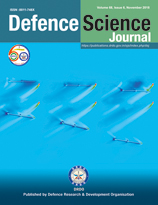Detection and Identification of Camouflaged Targets using Hyperspectral and LiDAR data
DOI:
https://doi.org/10.14429/dsj.68.12731Keywords:
Camouflaged target, ICA, HSI target detection, LiDAR classification, Decision level fusionAbstract
Camouflaging is the process of merging the target with the background with the aim to reduce/delay its detection. It can be done using different materials/methods such as camouflaging nets, paints. Defence applications often require quick detection of camouflaged targets in a dynamic battlefield scenario. Though HSI data may facilitate detection of camouflaged targets but detection gets complicated due to issues (spectral variability, dimensionality). This paper presents a framework for detection of camouflaged target that allows military analysts to coordinate and utilise the expert knowledge for resolving camouflaged targets using remotely sensed data. Desired camouflaged target (set of three chairs as a target under a camouflaging net) has been resolved in three steps: First, hyperspectral data processing helps to detect the locations of potential camouflaged targets. It narrows down the location of the potential camouflaged targets by detecting camouflaging net using Independent component analysis and spectral matching algorithms. Second, detection and identification have been performed using LiDAR point cloud classification and morphological analysis. HSI processing helps to discard the redundant majority of LiDAR point clouds and support detailed analysis of only the minute portion of the point cloud data the system deems relevant. This facilitates extraction of salient features of the potential camouflaged target. Lastly, the decisions obtained have been fused to infer the identity of the desired targets. The experimental results indicate that the proposed approach may be used to successfully resolve camouflaged target assuming some a priori knowledge about the morphology of targets likely to be present.
Downloads
Published
How to Cite
Issue
Section
License
 Where otherwise noted, the Articles on this site are licensed under Creative Commons License: CC Attribution-Noncommercial-No Derivative Works 2.5 India
Where otherwise noted, the Articles on this site are licensed under Creative Commons License: CC Attribution-Noncommercial-No Derivative Works 2.5 India


